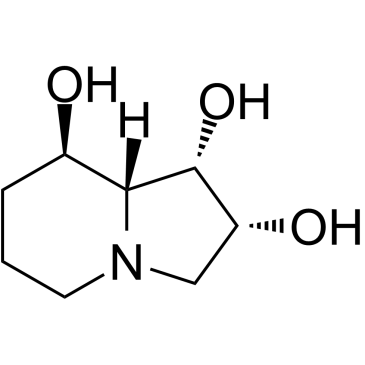Swainsonine as a lysosomal toxin affects dopaminergic neurons.
Qinfan Li, Yingzi Wang, Rudolf Moldzio, Weimin Lin, Wolf-Dieter Rausch
文献索引:J. Neural Transm. Gen. Sect. 119(12) , 1483-90, (2012)
全文:HTML全文
摘要
Swainsonine (SW) is an indolizidine triol plant alkaloid isolated from the species Astragalus, colloquially termed locoweed. When chronically ingested by livestock and wildlife, symptoms include severe neuronal disturbance. Toxicity to the central and peripheral nervous system is caused by inhibition of lysosomal α-mannosidase (AMA) and accumulation of intracellular oligosaccharide. Consequently, SW has been used as a model substance in investigations of lysosomal storage diseases. Involvement of the basal ganglia has been postulated due to the neuronal symptoms of affected animals. Therefore, primary midbrain cultures from embryonic mice containing dopaminergic neurons were utilized in this study. Neural cells were exposed to SW (0.01-100 μM) for 72 h. AMA activity was 50 % inhibited at 1 μM SW. Cytotoxic changes in cultures were observed above 25 μM SW by increases in lactate dehydrogenase activity and nitric oxide content. Neurotoxicity to dopaminergic cells was visualized by tyrosine hydroxylase immunohistochemistry. Structural degeneration scored as dendritic shortening and shrinkage of cell bodies was dose-dependent and resulted in nerve loss above 25 μM. SW exposure caused progression from reversible to irreversible cytotoxicity. Partial regeneration of AMA-activity in culture was observed on removal of SW. The antioxidative vitamins ascorbic acid and tocopherol (both 100 μM) partially reversed the toxic effect on dopaminergic cells and ascorbic acid decreased AMA inhibition. Thus, neuronal midbrain cell cultures can demonstrate the neurotoxic action of SW and cytoprotective strategies may be tested at a single nerve cell level.
相关化合物
| 结构式 | 名称/CAS号 | 分子式 | 全部文献 |
|---|---|---|---|
 |
八倾吲嗪三醇
CAS:72741-87-8 |
C8H15NO3 |
|
Production, HPLC analysis, and in situ apoptotic activities ...
2014-01-01 [Biotechnol. Prog. 30(5) , 1196-205, (2014)] |
|
DrugBank 3.0: a comprehensive resource for 'omics' research ...
2011-01-01 [Nucleic Acids Res. 39 , D1035-41., (2011)] |
|
Swainsonine inhibits growth and potentiates the cytotoxic ef...
2012-12-01 [Oncol. Rep. 28(6) , 2091-100, (2012)] |
|
Identification of a new locoweed (Oxytropis serioopetala) an...
2012-08-01 [J. Vet. Med. Sci. 74(8) , 989-93, (2012)] |
|
Optimization of different process variables for the producti...
2012-10-01 [J. Basic Microbiol. 52(5) , 590-7, (2012)] |